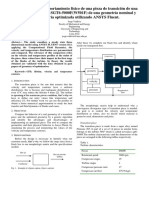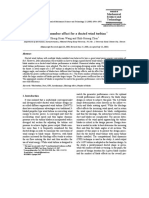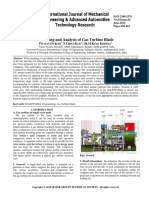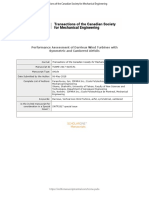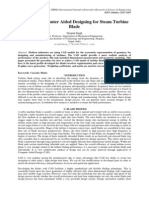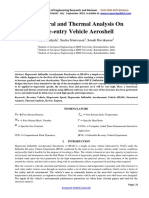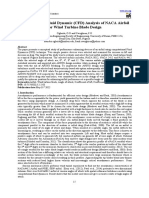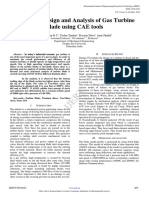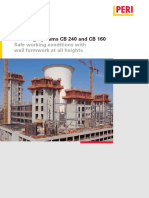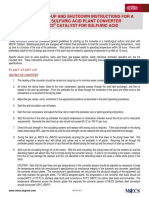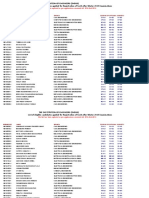Professional Documents
Culture Documents
Determination of Thermal Stresses On Turbine Blades
Original Title
Copyright
Available Formats
Share this document
Did you find this document useful?
Is this content inappropriate?
Report this DocumentCopyright:
Available Formats
Determination of Thermal Stresses On Turbine Blades
Copyright:
Available Formats
Volume 2, Issue 12, December– 2017 International Journal of Innovative Science and Research Technology
ISSN No:-2456 –2165
Determination of Thermal Stresses on Turbine Blades
of Gas Turbine with NACA Airfoils By Finite
Element Analysis
Anilkumar Konderu Ganesh Purushothaman
Dept. of Aerospace Engineer, from HAA Dept. of Aeronautical Engineer
Affiliated to IGNOU, Delhi Bangalore-37, India
Bangalore, India
Abstract— The compressor plays a vital role on jet engine a straight line drawn from the leading edge to the trailing edge
as it concerns about the initial compression on engine bleed of the airfoil. The blade shape is described by specifying the
system and aircraft cooling. They are two types of ratio of the chord to the camber at some particular length on
compressor used in jet engine. They are axial compressor the chord line, measured from the leading edge.
and centrifugal compressor. Here we discuss about the
axial-flow compressor. As its major application were are in II. DESIGN OF NACA AEROFOILS
large gas turbine engines. This paper investigates the
complications over the material selection, and temperature The airfoils are employed to accelerate and diffuse the air in
deformation that are majorly induced the stress the jet engines. The nomenclature describes the blade shapes
deformations of blade in operating with different rps of are almost identical to that of aircraft wings. In most
300 & 450, in the gas turbine engine. For this investigation, commercial axial flow compressors NACA series blades are
NACA6409, NACA64012 airfoils has been selected as base used.
model and these are modelled by using CAD tool CATIA
V5 and analysis had been done in ANSYS workbench 16.0,
with two various materials viz. Nimonic 80A, Inconel 625.
Keywords:-Jet Engine, Turbine Blade, Thermal Stress
Deformation, NACA6409, NACA64012, Catia V5, Ansys
Workbench 15.0, Nimonic 80A, Inconel 625.
I. INTRODUCTION
The axial flow compressor compresses its working fluid by
first accelerating the fluid and then diffusing it to obtain a
resuired pressure increase. The working fluid is accelerated by
a row of rotating airfoils (blades) called the rotor and then
diffused (decelerated) in a row of stationary (blades) the
stators. The axial flow compressor consists of a series of
stages, each stage comprising a row of rotor blades followed
by a row of stator blades. The accelerated fluid gains the
velocity increase in rotor blade and it later passages to stator Fig. 1. Cascade Model of NACA Airfoil
blade wherein the kinetic energy transferred in the rotor is
converted to static pressure. A set of one rotor and one stator A. Following Parameters has been Considered for Modelling
make-up a stage in a compressor. Frontal area in compressor the NACA Airfoils:
inlet, one additional row of fixed blades called Inlet Guide Inlet pressure: 5bar
Vanes (IGV) is commonly used to ensure that air enters the
Mass flow rate: 25kg/sec
first stage rotors at the desired angle. The last row of stator
vanes usually act as air straighteners to remove swirl from the Inlet temperature: 1250k
air to entry into the combustion system.
Rotational speed (N): 300rev/sec, 450rev/sec
The blades are curved in design, convex on one side is called Area of annular: 0.0692m2
suction side of blade and other side concave side is called
pressure side of the blade. The chord line of an airfoil is Mean blade speed U: 420m/sec
Um = 2πNrm
IJISRT17DC176 www.ijisrt.com 393
Volume 2, Issue 12, December– 2017 International Journal of Innovative Science and Research Technology
ISSN No:-2456 –2165
Height of the blade: ρ – Density of material
AN Acs – constant cross sectional area of blade
h = rb – distance b/w centre of rotor disc to tip of blade
U ω – Angular velocity
Radii of airfoil at root and tip Fc – Centrifugal force acting on per blade
h h C. Modelling Airfoils in CAD Tool:
rtip = rm+ ; rroot = rm - By using standard assumptions, theoretical calculations are
2 2 made to obtain the dimensions of the NACA 6409 & 64012
Adopting the height to chord (h/c) of 1.28: airfoils and modelled by using cad tool Catia V5 as shown in
height Fig 2. The design parameters are given in table I.
= 1.28
chord
NACA 6409 & 64012 with different rotational speeds
Parameters 300rps 450rps
Height 49.2mm 74.1mm
rroot 197.4mm 111.4mm
rtip 246mm 185.5mm
Chord 38.4mm 57.8mm
Table 1: NACA 6409 & 64012 with Different Rotational
Speeds
Mechanical properties of meaterials
Fig. 2. NACA Airfoil Model in Catia V5
Properties Inconel 625 Nimonic 80A
Density (kg/m3) 8440 8160 III. THERMAL STRESSES BY USING FEA
Tensile Modulus (mpa) 207500 222000
The finite element analysis for thermal stress analysis of gas
Possion’s Ratio 0.3 0.3 turbine engine, rotor blade is carried out by using Ansys 16.0
Yield Strength (mpa) 448 780 software. Catia models are imported to Ansys workbench for
simulating the thermal stresses on both NACA airfoils blades,
Thermal Conductivity 9.8 28.4
with two different materials at different speeds of 300rev/sec
(w/m-k)
and 450rev/sec. Discretization of geometry is done by using
Ansys meshing workbench, with multizone meshing technique
Table 2: Mechanical Properties of Materials
of solid90 elements.
B. Nomenclature:
α – Angle of attack
β – Inlet blade angle
θ – Camber angle
c – Chord length
s – Blade spacing
z – Position of max camber
i – Angle of incidence (α1 - β1)
t – Thickness of blade
AR – Aspect ratio of blade
γ – Stagger angle
h – Height of blade
rroot – Radius of blade at root
rtip – Radius of blade at tip
r m– Radius of mean rotor Fig. 3. Discretizing the Blade Geometry Using Ansys Wb
IJISRT17DC176 www.ijisrt.com 394
Volume 2, Issue 12, December– 2017 International Journal of Innovative Science and Research Technology
ISSN No:-2456 –2165
A. Boundary Conditions of Rotor Blade:s
Fig. 6. Heat Flux & Temperature Distribution of NACA
6409 of Inconel 625 At 450rev/Sec
Fig. 4. Load Acting Rotor Blade
Centrifugal force acting on per blade:
Fc = ρAω2 rb2 – rm2 Fig. 7. Heat Flux & Temperature Distribution of NACA
2 6409 of Nimonic80A At 300rev/Sec
RPM * 2π
ω= rad/sec
60
IV. RESULTS
To determine the thermal stresses, first steady state thermal
analysis is carried out for acquire temperature distribution and
heat flux for rotor blade.
Fig. 8. Heat Flux & Temperature Distribution of NACA
6409 of Nimonic80A At 450rev/Sec
Fig. 5. Heat Flux & Temperature Distribution of NACA
6409 of Inconel 625 At 300rev/Sec Fig. 9. Heat Flux & Temperature Distribution of NACA
64012 of Inconel 625 At 300rev/Sec
IJISRT17DC176 www.ijisrt.com 395
Volume 2, Issue 12, December– 2017 International Journal of Innovative Science and Research Technology
ISSN No:-2456 –2165
NACA 64012 heat flux (W/mm2)
Rev/sec Inconel 625 Nimonic 80A
300 2.6424 8.4396
450 6.5685 1.4875
Table 4: NACA 64012 Heat Flux (W/mn2)
The obtained thermal results are coupled to the static structural
analysis to acquire the equivalent stresses and displacements,
with participated centrifugal loads on rotor blade.
Fig. 10. Heat Flux & Temperature Distribution of NACA
64012 of Inconel 625 At 450rev/Sec
Fig. 13. Eqv Stress & Total Deformation of NACA 6409 of
Fig. 11. Heat Flux & Temperature Distribution of NACA Inconel 625 At 300rev/Sec
64012 of Nimonic80A At 300rev/Sec
Fig. 14. Eqv Stress & Total Deformation of NACA 6409 of
Inconel 625 At 450rev/Sec
Fig. 12. heat flux & Temperature distribution of NACA
64012 of Nimonic at 450rev/sec
NACA 6409 heat flux (W/mm2)
Rev/sec Inconel 625 Nimonic 80A
300 3.1522 8.4396
450 1.3827 1.4875
Table 3: NACA 6409 Heat Flux (w/mn2) Fig. 15. EQV Stress & Total Deformation of NACA 6409 of
Nimonic80A At 300rev/Sec
IJISRT17DC176 www.ijisrt.com 396
Volume 2, Issue 12, December– 2017 International Journal of Innovative Science and Research Technology
ISSN No:-2456 –2165
Fig. 19. Eqv Stress & Total Deformation of NACA 64012 of
Fig. 16. Eqv Stress & Total Deformation of NACA 6409 of Nimonic 80A at 300rev/sec
Nimonic80A At 450rev/Sec
Fig. 20. Eqv Stress & Total Deformation of NACA 64012 of
Fig. 17. Eqv Stress & Total Deformation of NACA 64012 of
Nimonic 80A at 450rev/sec
Inconel 625 At 300rev/Sec
NACA 6409 at 300rev/sec
parameters Inconel 625 Nimonic 80A
Deformations (mm) 0.3609 0.379
Eqv Stress (MPa) 382.41 538.8
Table 5: NACA 6409 AT 300rev / sec
NACA 6409 at 450rev/sec
parameters Inconel 625 Nimonic 80A
Deformations (mm) 0.8250 0.7711
Eqv Stress (MPa) 663.41 663.41
Fig. 18. EQV Stress & Total Deformation of NACA 64012 of
Inconel 625 At 450rev/Sec
Table 6: NACA 6409 at 450rev/sec
IJISRT17DC176 www.ijisrt.com 397
Volume 2, Issue 12, December– 2017 International Journal of Innovative Science and Research Technology
ISSN No:-2456 –2165
[7]. Meherwan P. Boyce, “Gas Turbine Engineering
NACA 64012 at 300rev/sec Handbook”.
parameters Inconel 625 Nimonic 80A
Deformations (mm) 0.2137 0.1931
Eqv Stress (MPa) 367.04 354.83
Table 7: NACA 64012 at 300rev/sec
NACA 64012 at 450rev/sec
parameters Inconel 625 Nimonic 80A
Deformations (mm) 0.6857 0.6196
Eqv Stress (MPa) 513.05 496.01
Table 8: NACA 64012 at 450rev/sec
V. CONCLUSION
• Both the materials with different rpm and airfoils, are
given considerable results, but final conclusion can be
done on the basis of stresses induced in the material.
• The temperature distribution is depends upon the heat
transfer coefficient and thermal conductivity of the
material.
• From the results we can observe the maximum
temperature at the root of the blade due to stagnation
effects at root.
• Heat flux is marginally lower on NACA 6409 airfoil at
450rev/sec of Inconel 625 material, because of lower
thermal conductivity.
• NACA 64012 airfoil at the speed of 300rev/sec, has
induced comparatively lesser stress than yield strength of
the material; with Nimonic 80A material, because of
young’s modulus of material.
• More stresses are induced at the blade root, because of,
blade is cantilever (one end is fixed)
• From this analysis it is concluded that Nimonic 80A
material can be used for gas turbine rotor blade.
REFERNCES
[1]. Ravi Ranjan Kumar and Prof. K. M. Pandey, “Static
Structural and Modal Analysis of Gas Turbine Blade” IOP
Conf. Series: Materials Science and Engineering 225
(2017) 012102.
[2]. Win Lai Htwe, Htay Htay Win, Nyein Aye San,
“DESIGN AND THERMAL ANALYSIS OF GAS
TURBINE BLADE”, International Journal of Mechanical
and Production Engineering, ISSN: 2320-2092, Volume-
3, Issue-7.
[3]. Theju V1, Uday P S, “Design and Analysis of Gas
Turbine Blade”, ISSN: 2319-8753, Vol. 3, Issue 6.
[4]. Prof. Q. H. Nagpurwala, “Design of Axial Flow Turbine-
1” M S Ramaiah School of Advanced Studies, Bengaluru.
[5]. Forces on Large Steam Turbine Blades by RWE power.
[6]. Prof. M. D. Deshpande, “Airfoil design”, M S Ramaiah
School of Advanced Studies, Bengaluru.
IJISRT17DC176 www.ijisrt.com 398
You might also like
- Aerodynamic and Modal Analyses of Blades For Small Wind TurbinesDocument8 pagesAerodynamic and Modal Analyses of Blades For Small Wind TurbinesDimitri OliveiraNo ratings yet
- Modeling and Analysis of Steam Turbine Blade-Ijaerdv05i0451562n PDFDocument11 pagesModeling and Analysis of Steam Turbine Blade-Ijaerdv05i0451562n PDFGuruvenu KamanuruNo ratings yet
- Flutter Analysis of Last Stage Steam Turbine PowerDocument14 pagesFlutter Analysis of Last Stage Steam Turbine Powerji.lang.vuNo ratings yet
- Irjet V6i41207Document4 pagesIrjet V6i41207Adarsh r krishnaNo ratings yet
- Thermal Design-Tm - 17Document10 pagesThermal Design-Tm - 17VilasNo ratings yet
- Performance Enhancement of Low Pressure Turbine Cascade by Introducing TuberclesDocument7 pagesPerformance Enhancement of Low Pressure Turbine Cascade by Introducing TuberclesInternational Journal of Innovative Science and Research Technology100% (1)
- AWS3 Technical Design for IEC 64100-2 ComplianceDocument57 pagesAWS3 Technical Design for IEC 64100-2 ComplianceĐặng Tấn PhátNo ratings yet
- 0011 Structural Design of A Composite Wind Turbine Blade Using FiniteDocument8 pages0011 Structural Design of A Composite Wind Turbine Blade Using FiniteKhalil DeghoumNo ratings yet
- 21 Ijmperddec201821Document10 pages21 Ijmperddec201821TJPRC PublicationsNo ratings yet
- PAPER. (FINETURBO) Investigation of A Steam Turbine With Leaned Blades by Through Flow Analysis and 3D CFD SimulationDocument6 pagesPAPER. (FINETURBO) Investigation of A Steam Turbine With Leaned Blades by Through Flow Analysis and 3D CFD SimulationCJ QuahNo ratings yet
- Analisis Ketahanan Beban Dinamis Material Turbin Angin Terhadap Kecepatan Putar Rotor (RPM) Menggunakan Metode Elemen HinggaDocument7 pagesAnalisis Ketahanan Beban Dinamis Material Turbin Angin Terhadap Kecepatan Putar Rotor (RPM) Menggunakan Metode Elemen Hinggacatur harsitoNo ratings yet
- Structural & Thermal Analysis of Gas Turbine Blade by Using F.E.MDocument6 pagesStructural & Thermal Analysis of Gas Turbine Blade by Using F.E.MijsretNo ratings yet
- Numerical Analysis of Aerodynamic Performance Characteristics of NACA 2312 and NACA 2412Document9 pagesNumerical Analysis of Aerodynamic Performance Characteristics of NACA 2312 and NACA 2412International Journal of Innovative Science and Research TechnologyNo ratings yet
- 2005-4246 IJUNESST Copyright 2014 SERSC Selection of A Suitable Material and Failure Investigation On A Turbine Blade of Marine Gas Turbine Engine Using Reverse Engineering and FEA TechniquesDocument12 pages2005-4246 IJUNESST Copyright 2014 SERSC Selection of A Suitable Material and Failure Investigation On A Turbine Blade of Marine Gas Turbine Engine Using Reverse Engineering and FEA TechniquesChanduReddyNo ratings yet
- Paper ValdiviaDocument3 pagesPaper ValdiviaJorge Luis Valdivia ParedesNo ratings yet
- Analysis of Supercritical Airfoils for Increasing Critical Mach NumberDocument5 pagesAnalysis of Supercritical Airfoils for Increasing Critical Mach Numberashok pandiyanNo ratings yet
- Design, Fabrication and Analysis of Fibonacci TurbineDocument5 pagesDesign, Fabrication and Analysis of Fibonacci TurbinearcaldartNo ratings yet
- The Design and Analysis of Gas Turbine Blade: Research PaperDocument3 pagesThe Design and Analysis of Gas Turbine Blade: Research PaperSai SushmaNo ratings yet
- Control of Boundary Layer Build-Up in An Impeller: C. Nithiyapathi & B. AkilanDocument6 pagesControl of Boundary Layer Build-Up in An Impeller: C. Nithiyapathi & B. AkilanTJPRC PublicationsNo ratings yet
- 03_raditator fan CFDDocument4 pages03_raditator fan CFDkcpatnaikNo ratings yet
- Analisis Ketahanan Beban Dinamis Material Turbin ADocument7 pagesAnalisis Ketahanan Beban Dinamis Material Turbin ALasinta Ari Nendra WibawaNo ratings yet
- Wind Tunnel Tests of The NACA 63-415 and A Modified NACA 63-415 AirfoilDocument109 pagesWind Tunnel Tests of The NACA 63-415 and A Modified NACA 63-415 AirfoilAlejandro Sergio FerenzNo ratings yet
- Blade Number Effect For A Ducted Wind TurbineDocument9 pagesBlade Number Effect For A Ducted Wind TurbineAnonymous LnQ4lBXiPjNo ratings yet
- Effects of NACA 65-BladeDocument6 pagesEffects of NACA 65-BladeRonaldo LeiteNo ratings yet
- Turbine Blade Design of A Micro Gas Turbine: Vellore Institute of Technlogy, Vellore - 632014, IndiaDocument6 pagesTurbine Blade Design of A Micro Gas Turbine: Vellore Institute of Technlogy, Vellore - 632014, Indiakamran kainporNo ratings yet
- Materials Today: Proceedings: Bhupinder Singh, Harjot Singh GillDocument5 pagesMaterials Today: Proceedings: Bhupinder Singh, Harjot Singh GillJuan ApzNo ratings yet
- CFD Analysis of A Gas Turbine Blade Cooling in The Presence of HolesDocument11 pagesCFD Analysis of A Gas Turbine Blade Cooling in The Presence of HolesShivam KumarNo ratings yet
- Thermal Analysis of Composite Steam Turbine BladesDocument6 pagesThermal Analysis of Composite Steam Turbine BladesInternational Journal of Innovative Science and Research TechnologyNo ratings yet
- Blade DesignDocument9 pagesBlade DesignMuhammad ZahidNo ratings yet
- Design Calculation of Lab-Scaled Small Wind Turbine With NACA 4412 Airfoil (12watt)Document4 pagesDesign Calculation of Lab-Scaled Small Wind Turbine With NACA 4412 Airfoil (12watt)José Renato Guerrero MezaNo ratings yet
- 251-Article Text-452-1-10-20180925Document6 pages251-Article Text-452-1-10-20180925aravisara5No ratings yet
- CFD Analysis & Experimental Investigation of NACA0018 Blade Profile For Darrieus TurbineDocument9 pagesCFD Analysis & Experimental Investigation of NACA0018 Blade Profile For Darrieus TurbineInternational Journal of Application or Innovation in Engineering & ManagementNo ratings yet
- Static and Thermal Analysis of Gas Turbine Rotor BladeDocument15 pagesStatic and Thermal Analysis of Gas Turbine Rotor BladeJUKANTI VISHWASNo ratings yet
- Flow Behaiviour Over Supercritical Aerofoil Respective To Naca AerofoilDocument8 pagesFlow Behaiviour Over Supercritical Aerofoil Respective To Naca AerofoilTapasya NathNo ratings yet
- Design of 250 W AC Series MotorDocument3 pagesDesign of 250 W AC Series MotorMiguel ArzamendiaNo ratings yet
- Vertical Axis Wind TurbineDocument5 pagesVertical Axis Wind TurbineJournalNX - a Multidisciplinary Peer Reviewed JournalNo ratings yet
- Modelling and Analysis of Gas Turbine BLDocument5 pagesModelling and Analysis of Gas Turbine BLHaneen Safwat ArabNo ratings yet
- PARAMETRIC STUDY ON EFFICIENCY OF ARCHIMEDES SCREW TURBINE DESIGN - UpdatedDocument4 pagesPARAMETRIC STUDY ON EFFICIENCY OF ARCHIMEDES SCREW TURBINE DESIGN - UpdatedRoberto Zambrano SepulvedaNo ratings yet
- Career Episode 2 Modelling and Simulation of Gas Turbine Blade Using Different MaterialsDocument7 pagesCareer Episode 2 Modelling and Simulation of Gas Turbine Blade Using Different MaterialsNishar Alam Khan 19MCD0042No ratings yet
- Thermal Analysis of Gas Turbine Blade MaterialsDocument13 pagesThermal Analysis of Gas Turbine Blade Materialsmanufacturing Tech airfieldNo ratings yet
- Tcsme 2017 0105Document36 pagesTcsme 2017 0105د. معتز الجامعيNo ratings yet
- Design of Small Horizontal Axis Wind Turbine For Low Wind Speed RuralDocument7 pagesDesign of Small Horizontal Axis Wind Turbine For Low Wind Speed RuralFAIZ100% (1)
- Applying Computer Aided Designing For Steam Turbine BladeDocument6 pagesApplying Computer Aided Designing For Steam Turbine Blademishranamit2211100% (1)
- Design and Thermo Structural Stress Analysis of Axial Flow Gas Turbine BliskDocument8 pagesDesign and Thermo Structural Stress Analysis of Axial Flow Gas Turbine BliskTJPRC PublicationsNo ratings yet
- Design Calculation of 1200W Horizontal Axis Wind Turbine Blade For Rural ApplicationsDocument3 pagesDesign Calculation of 1200W Horizontal Axis Wind Turbine Blade For Rural ApplicationsEditor IJTSRDNo ratings yet
- Surrogate-Based Optimization of A Biplane Wells Turbine: Tapas K. Das and Abdus SamadDocument10 pagesSurrogate-Based Optimization of A Biplane Wells Turbine: Tapas K. Das and Abdus SamadMurali K oe16d017No ratings yet
- Ijeas0304004 PDFDocument3 pagesIjeas0304004 PDFerpublicationNo ratings yet
- Parametric Study of Centrifugal Fan Performance ExDocument19 pagesParametric Study of Centrifugal Fan Performance ExlolNo ratings yet
- To Optimize The Design of The Basket ProDocument6 pagesTo Optimize The Design of The Basket ProgikkederkiNo ratings yet
- Simulations of Supercritical Aerofoil at Different Angle of Attack With A Simple Aerofoil Using FluentDocument10 pagesSimulations of Supercritical Aerofoil at Different Angle of Attack With A Simple Aerofoil Using FluentRavi ShankarNo ratings yet
- Structural and Thermal-3452Document21 pagesStructural and Thermal-3452ayinam sai mohanNo ratings yet
- 17_GT2011-45243-An Aerodynamic Design Methodology for Low Pressure Axial Fans WithDocument9 pages17_GT2011-45243-An Aerodynamic Design Methodology for Low Pressure Axial Fans WithkcpatnaikNo ratings yet
- Computational Fluid Dynamic (CFD) Analysis of NACA Airfoil For Wind Turbine Blade DesignDocument17 pagesComputational Fluid Dynamic (CFD) Analysis of NACA Airfoil For Wind Turbine Blade DesignDiptoNo ratings yet
- Putra Adnan 2018 J. Phys. Conf. Ser. 1005 012026Document13 pagesPutra Adnan 2018 J. Phys. Conf. Ser. 1005 012026uma shankarNo ratings yet
- Structural Design and Analysis of Gas Turbine Blade Using Cae Tools IJERTV3IS100482Document6 pagesStructural Design and Analysis of Gas Turbine Blade Using Cae Tools IJERTV3IS100482Sai SushmaNo ratings yet
- Propeller design with modified velocity for improved coolingDocument11 pagesPropeller design with modified velocity for improved coolingfelip987No ratings yet
- WindDocument13 pagesWindBoopathi KalaiNo ratings yet
- Design and Analysis of Axial Flow Turbine With Computer SoftwareDocument8 pagesDesign and Analysis of Axial Flow Turbine With Computer SoftwareMusab muaz sarıNo ratings yet
- Advances in Machine Tool Design and Research 1967: Proceedings of the 8th International M.T.D.R. Conference (Incorporating the 2nd International CIRP Production Engineering Research Conference), the University of Manchester Institute of Science and Technology, September 1967From EverandAdvances in Machine Tool Design and Research 1967: Proceedings of the 8th International M.T.D.R. Conference (Incorporating the 2nd International CIRP Production Engineering Research Conference), the University of Manchester Institute of Science and Technology, September 1967S. A. TobiasNo ratings yet
- A Curious Case of QuadriplegiaDocument4 pagesA Curious Case of QuadriplegiaInternational Journal of Innovative Science and Research TechnologyNo ratings yet
- Analysis of Financial Ratios that Relate to Market Value of Listed Companies that have Announced the Results of their Sustainable Stock Assessment, SET ESG Ratings 2023Document10 pagesAnalysis of Financial Ratios that Relate to Market Value of Listed Companies that have Announced the Results of their Sustainable Stock Assessment, SET ESG Ratings 2023International Journal of Innovative Science and Research TechnologyNo ratings yet
- Adoption of International Public Sector Accounting Standards and Quality of Financial Reporting in National Government Agricultural Sector Entities, KenyaDocument12 pagesAdoption of International Public Sector Accounting Standards and Quality of Financial Reporting in National Government Agricultural Sector Entities, KenyaInternational Journal of Innovative Science and Research TechnologyNo ratings yet
- Food habits and food inflation in the US and India; An experience in Covid-19 pandemicDocument3 pagesFood habits and food inflation in the US and India; An experience in Covid-19 pandemicInternational Journal of Innovative Science and Research TechnologyNo ratings yet
- The Students’ Assessment of Family Influences on their Academic MotivationDocument8 pagesThe Students’ Assessment of Family Influences on their Academic MotivationInternational Journal of Innovative Science and Research Technology100% (1)
- Pdf to Voice by Using Deep LearningDocument5 pagesPdf to Voice by Using Deep LearningInternational Journal of Innovative Science and Research TechnologyNo ratings yet
- Fruit of the Pomegranate (Punica granatum) Plant: Nutrients, Phytochemical Composition and Antioxidant Activity of Fresh and Dried FruitsDocument6 pagesFruit of the Pomegranate (Punica granatum) Plant: Nutrients, Phytochemical Composition and Antioxidant Activity of Fresh and Dried FruitsInternational Journal of Innovative Science and Research TechnologyNo ratings yet
- Forensic Evidence Management Using Blockchain TechnologyDocument6 pagesForensic Evidence Management Using Blockchain TechnologyInternational Journal of Innovative Science and Research TechnologyNo ratings yet
- Improvement Functional Capacity In Adult After Percutaneous ASD ClosureDocument7 pagesImprovement Functional Capacity In Adult After Percutaneous ASD ClosureInternational Journal of Innovative Science and Research TechnologyNo ratings yet
- Machine Learning and Big Data Analytics for Precision Cardiac RiskStratification and Heart DiseasesDocument6 pagesMachine Learning and Big Data Analytics for Precision Cardiac RiskStratification and Heart DiseasesInternational Journal of Innovative Science and Research TechnologyNo ratings yet
- Optimization of Process Parameters for Turning Operation on D3 Die SteelDocument4 pagesOptimization of Process Parameters for Turning Operation on D3 Die SteelInternational Journal of Innovative Science and Research TechnologyNo ratings yet
- Scrolls, Likes, and Filters: The New Age Factor Causing Body Image IssuesDocument6 pagesScrolls, Likes, and Filters: The New Age Factor Causing Body Image IssuesInternational Journal of Innovative Science and Research TechnologyNo ratings yet
- The Experiences of Non-PE Teachers in Teaching First Aid and Emergency Response: A Phenomenological StudyDocument89 pagesThe Experiences of Non-PE Teachers in Teaching First Aid and Emergency Response: A Phenomenological StudyInternational Journal of Innovative Science and Research TechnologyNo ratings yet
- Design and Implementation of Homemade Food Delivery Mobile Application Using Flutter-FlowDocument7 pagesDesign and Implementation of Homemade Food Delivery Mobile Application Using Flutter-FlowInternational Journal of Innovative Science and Research TechnologyNo ratings yet
- Severe Residual Pulmonary Stenosis after Surgical Repair of Tetralogy of Fallot: What’s Our Next Strategy?Document11 pagesSevere Residual Pulmonary Stenosis after Surgical Repair of Tetralogy of Fallot: What’s Our Next Strategy?International Journal of Innovative Science and Research TechnologyNo ratings yet
- Comparison of Lateral Cephalograms with Photographs for Assessing Anterior Malar Prominence in Maharashtrian PopulationDocument8 pagesComparison of Lateral Cephalograms with Photographs for Assessing Anterior Malar Prominence in Maharashtrian PopulationInternational Journal of Innovative Science and Research TechnologyNo ratings yet
- Late Presentation of Pulmonary Hypertension Crisis Concurrent with Atrial Arrhythmia after Atrial Septal Defect Device ClosureDocument12 pagesLate Presentation of Pulmonary Hypertension Crisis Concurrent with Atrial Arrhythmia after Atrial Septal Defect Device ClosureInternational Journal of Innovative Science and Research TechnologyNo ratings yet
- Blockchain-Enabled Security Solutions for Medical Device Integrity and Provenance in Cloud EnvironmentsDocument13 pagesBlockchain-Enabled Security Solutions for Medical Device Integrity and Provenance in Cloud EnvironmentsInternational Journal of Innovative Science and Research TechnologyNo ratings yet
- A Review on Process Parameter Optimization in Material Extrusion Additive Manufacturing using ThermoplasticDocument4 pagesA Review on Process Parameter Optimization in Material Extrusion Additive Manufacturing using ThermoplasticInternational Journal of Innovative Science and Research TechnologyNo ratings yet
- Enhancing Biometric Attendance Systems for Educational InstitutionsDocument7 pagesEnhancing Biometric Attendance Systems for Educational InstitutionsInternational Journal of Innovative Science and Research TechnologyNo ratings yet
- Quality By Plan Approach-To Explanatory Strategy ApprovalDocument4 pagesQuality By Plan Approach-To Explanatory Strategy ApprovalInternational Journal of Innovative Science and Research TechnologyNo ratings yet
- Design and Development of Controller for Electric VehicleDocument4 pagesDesign and Development of Controller for Electric VehicleInternational Journal of Innovative Science and Research TechnologyNo ratings yet
- Targeted Drug Delivery through the Synthesis of Magnetite Nanoparticle by Co-Precipitation Method and Creating a Silica Coating on itDocument6 pagesTargeted Drug Delivery through the Synthesis of Magnetite Nanoparticle by Co-Precipitation Method and Creating a Silica Coating on itInternational Journal of Innovative Science and Research TechnologyNo ratings yet
- Investigating the Impact of the Central Agricultural Research Institute's (CARI) Agricultural Extension Services on the Productivity and Livelihoods of Farmers in Bong County, Liberia, from 2013 to 2017Document12 pagesInvestigating the Impact of the Central Agricultural Research Institute's (CARI) Agricultural Extension Services on the Productivity and Livelihoods of Farmers in Bong County, Liberia, from 2013 to 2017International Journal of Innovative Science and Research TechnologyNo ratings yet
- Databricks- Data Intelligence Platform for Advanced Data ArchitectureDocument5 pagesDatabricks- Data Intelligence Platform for Advanced Data ArchitectureInternational Journal of Innovative Science and Research TechnologyNo ratings yet
- Digital Pathways to Empowerment: Unraveling Women's Journeys in Atmanirbhar Bharat through ICT - A Qualitative ExplorationDocument7 pagesDigital Pathways to Empowerment: Unraveling Women's Journeys in Atmanirbhar Bharat through ICT - A Qualitative ExplorationInternational Journal of Innovative Science and Research TechnologyNo ratings yet
- Anxiety, Stress and Depression in Overseas Medical Students and its Associated Factors: A Descriptive Cross-Sectional Study at Jalalabad State University, Jalalabad, KyrgyzstanDocument7 pagesAnxiety, Stress and Depression in Overseas Medical Students and its Associated Factors: A Descriptive Cross-Sectional Study at Jalalabad State University, Jalalabad, KyrgyzstanInternational Journal of Innovative Science and Research Technology90% (10)
- Gardening Business System Using CNN – With Plant Recognition FeatureDocument4 pagesGardening Business System Using CNN – With Plant Recognition FeatureInternational Journal of Innovative Science and Research TechnologyNo ratings yet
- Optimizing Sound Quality and Immersion of a Proposed Cinema in Victoria Island, NigeriaDocument4 pagesOptimizing Sound Quality and Immersion of a Proposed Cinema in Victoria Island, NigeriaInternational Journal of Innovative Science and Research TechnologyNo ratings yet
- Development of a Local Government Service Delivery Framework in Zambia: A Case of the Lusaka City Council, Ndola City Council and Kafue Town Council Roads and Storm Drain DepartmentDocument13 pagesDevelopment of a Local Government Service Delivery Framework in Zambia: A Case of the Lusaka City Council, Ndola City Council and Kafue Town Council Roads and Storm Drain DepartmentInternational Journal of Innovative Science and Research TechnologyNo ratings yet
- Cube Nets Non-Verbal Reasoning IntroductionDocument6 pagesCube Nets Non-Verbal Reasoning Introductionmirali74No ratings yet
- 100 kWp Rooftop Solar PV Plant Project Report for Ghaziabad FactoryDocument25 pages100 kWp Rooftop Solar PV Plant Project Report for Ghaziabad FactoryvikashNo ratings yet
- CB Climbing Bracket PERIDocument52 pagesCB Climbing Bracket PERINathan FryerNo ratings yet
- Theory of Financial Decision Making PDFDocument392 pagesTheory of Financial Decision Making PDFEmmanuel K'pkorNo ratings yet
- State-Of-The-Art CFB Technology For Utility-Scale Biomass Power PlantsDocument10 pagesState-Of-The-Art CFB Technology For Utility-Scale Biomass Power PlantsIrfan OmercausevicNo ratings yet
- Lumion PRO 5Document6 pagesLumion PRO 5paparock34No ratings yet
- Swiftautoid SA T9680 Black Series 2D Imager Andriod Industrial TabletDocument2 pagesSwiftautoid SA T9680 Black Series 2D Imager Andriod Industrial TabletAirul MutaqinNo ratings yet
- Application Research of MRAC in Fault-Tolerant Flight ControllerDocument1 pageApplication Research of MRAC in Fault-Tolerant Flight ControlleradcadNo ratings yet
- AVR R448: SpecificationDocument2 pagesAVR R448: SpecificationAish MohammedNo ratings yet
- SM Maintenance Instructions: Author: Lars Rydén, Konecranes AB, SwedenDocument132 pagesSM Maintenance Instructions: Author: Lars Rydén, Konecranes AB, SwedenDan VekasiNo ratings yet
- Air Suspension Benefits Over Steel SpringsDocument3 pagesAir Suspension Benefits Over Steel SpringsBejoy G NairNo ratings yet
- Reinforcement Detailing in BeamsDocument9 pagesReinforcement Detailing in Beamssaheed tijaniNo ratings yet
- 34 DuPont MECS Startup Shutdown Procedure For MET Plants Sulfuric AcidDocument4 pages34 DuPont MECS Startup Shutdown Procedure For MET Plants Sulfuric AcidLouis Andree Bujanda RufattNo ratings yet
- Topic 4 - Chemical Kinetics 4b - Half LifeDocument20 pagesTopic 4 - Chemical Kinetics 4b - Half LifeJoshua LaBordeNo ratings yet
- Step 1: State The Null and Alternative HypothesisDocument3 pagesStep 1: State The Null and Alternative HypothesisChristine Joyce BascoNo ratings yet
- Analisis Matricial Mario Paz PDFDocument326 pagesAnalisis Matricial Mario Paz PDFLeonardo Chavarro Velandia100% (1)
- The Chemistry of Gemstone Colours 2016Document1 pageThe Chemistry of Gemstone Colours 2016Lukau João PedroNo ratings yet
- Eclipse RCPDocument281 pagesEclipse RCPjpradeebanNo ratings yet
- Artikel Materi Skripsi - Qurrotu Aini-2Document13 pagesArtikel Materi Skripsi - Qurrotu Aini-2Qurrotu AiniNo ratings yet
- Modeling Confined Masonry Walls with OpeningsDocument11 pagesModeling Confined Masonry Walls with OpeningsMangisi Haryanto ParapatNo ratings yet
- Experiment List (FEE)Document5 pagesExperiment List (FEE)bpkeleNo ratings yet
- Lesson Statement Sheet.Document2 pagesLesson Statement Sheet.Anya AshuNo ratings yet
- CO Limba Engleza, Anul 2Document56 pagesCO Limba Engleza, Anul 2Bocaneala Gianina100% (1)
- List of Eligible Candidates Applied For Registration of Secb After Winter 2015 Examinations The Institution of Engineers (India)Document9 pagesList of Eligible Candidates Applied For Registration of Secb After Winter 2015 Examinations The Institution of Engineers (India)Sateesh NayaniNo ratings yet
- Quasi VarianceDocument2 pagesQuasi Varianceharrison9No ratings yet
- Deep Learning: Huawei AI Academy Training MaterialsDocument47 pagesDeep Learning: Huawei AI Academy Training Materialsfadhil muhammad hanafiNo ratings yet
- Assignment No.3 Bolted JointsDocument6 pagesAssignment No.3 Bolted JointsYash SahuNo ratings yet
- A-019730-1647416754604-137865-W.M.Supun Anjana DSADocument175 pagesA-019730-1647416754604-137865-W.M.Supun Anjana DSADishan SanjayaNo ratings yet
- Standard Rotary Pulse Encoder Operation Replacement SettingDocument8 pagesStandard Rotary Pulse Encoder Operation Replacement SettingGuesh Gebrekidan50% (2)
- Peabody y Movent ABCDocument11 pagesPeabody y Movent ABCIngrid BarkoNo ratings yet














